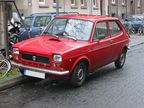Year of Fiat 127
Fiat 127 photos, specs - Car Pictures & Images
 The Fiat 127 is a supermini produced by the Italian automaker Fiat between 1971 and 1983. It was introduced in 1971 as the replacement for the Fiat 850. Production of the 127 in Italy ended in 1983 following the introduction of its replacement, the Fiat Uno. Initially only available as a two-door saloon, a three-door hatchback using an identical body profile was launched the following year — Fiat's first in the class. The 127 used the tried and trusted 903 cc overhead valve engine that had powered many earlier generations of Fiat cars, in conjunction with the state-of-the-art transverse engine and front wheel drive layout which had been pioneered in the Autobianchi Primula (Autobianchi was a Fiat subsidiary) and the Fiat 128, and also featured a unique transverse leaf spring suspension at the rear. The car was one of the first of the modern superminis, and won praise for its utilisation of space (80 percent of the floor space was available for passengers and luggage) as well as its road-holding. The 127 was an instant success, winning the European Car of the Year award in 1972, and quickly became one of the best-selling cars in Europe for several years. |
The Series 2 version of the 127 debuted in 1977. It featured a restyled front and rear, a revised dashboard, larger rear glass area and a new 1049 cc engine option. This aluminium headed, overhead cam engine was unique to the 127 range. At the same time a 5-door derivative became available in certain countries. The final revision of the 127 came in 1982 with the Mark 3. Once again the front and end styling was freshened up, and a new 1301 cc engine option was introduced. The interior was redesigned and made more modern looking. There was also a "high-cube" panel van version, known as the Fiorino which was based on the Series 2 bodyshell, and this remained in production until 1984, when a new Uno-based Fiorino debuted. The Series 3 was launched in Italy in January 1982 and soon reached other European markets. It is distinguishable from the Series 2 by a more assertively plastic grille. The addition of a corresponding panel at the rear of the vehicle implied a new 'house style' inspired by the recently introduced Fiat Ritmo. The 127 was replaced as Fiat's high volume product in this sector by the Fiat Uno in January 1983, though versions manufactured in South America continued in production till 1995: Fiat imported the South American 127 Unificata to Europe, until 1987. As happened with other Fiat models of that era, SEAT made a Spanish version of this car called the SEAT 127. Due to SEAT design policy, a 4-door variant of the car was produced. SEAT also produced a unique variant of the 127 OHV engine. This had 1010 cc instead of 903 cc and produced 50 bhp. When their licence from Fiat expired, SEAT redesigned some parts of the car and created the SEAT Fura Dos. Some design parts of this model were also used in the Ibiza mark 1. SEAT produced 1,238,166 units of the 127 between 1972 and 1984. In Brazil a 3-door wagon version was produced, called Fiat 147, one version actually utilizing a 1.3L Diesel engine. From 1981 this variant was actually exported to Europe, to be sold alongside the 127 sedans and hatchbacks. A total of 1,169,312 units were built from 9 July 1976 to the end of 1985 in Brazil and 232,807 units were also built in Argentina between 1982 and 1996, as the Fiat 147 or Spazio. Although the car achieved reasonable selling figures, the model was titled as "low-level" and "not so reliable" by early buyers, because the fact that Fiat was just starting selling cars in Brazil in the late 70s and early 80s. » Read More About Fiat 127 |




